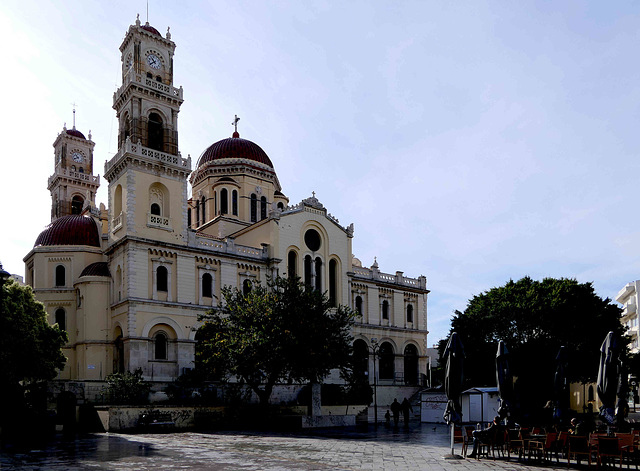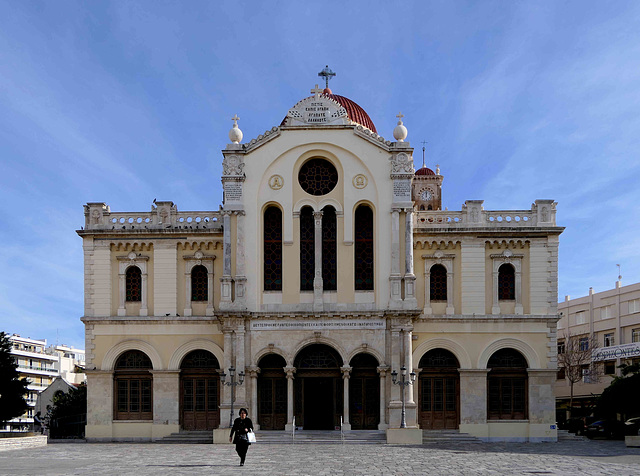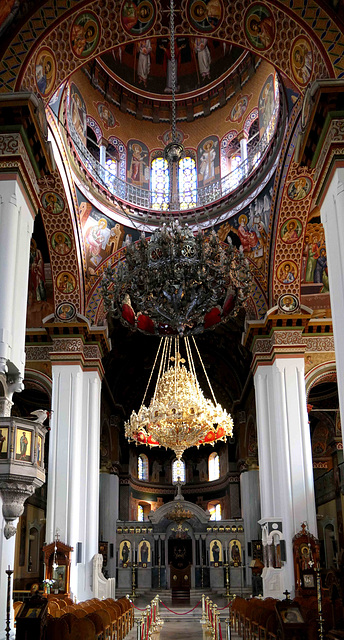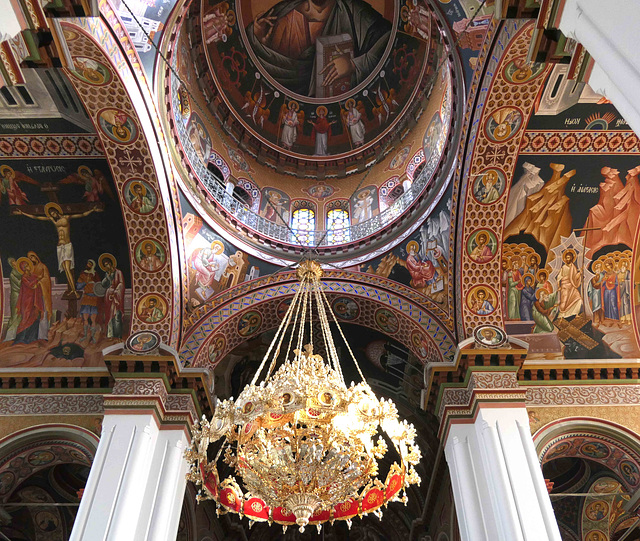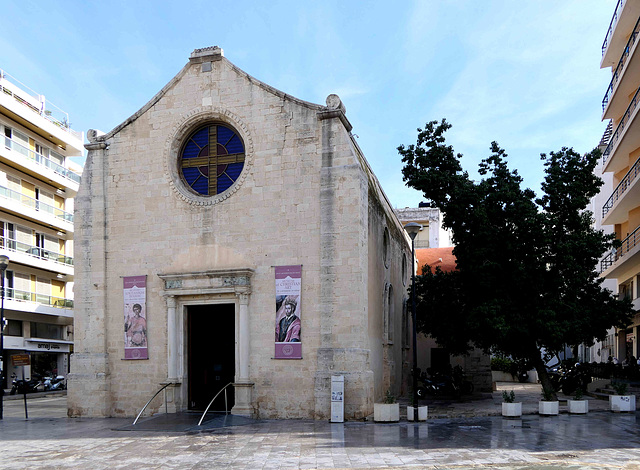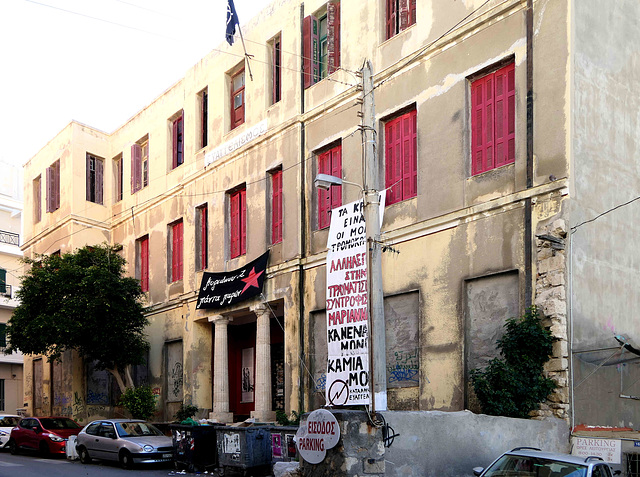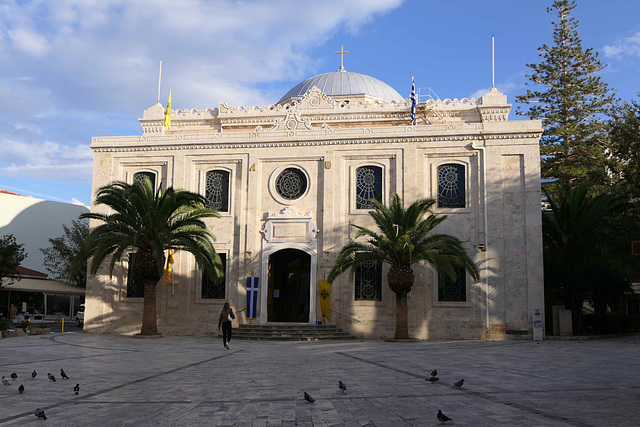
Greece
Heraklion - Agios Minas Cathedral
Crete is the largest and most populous of the Greek islands, is located about 100 km south of the Peloponnese. Crete was the center of Europe's first advanced civilization, the Minoans, from 3000 to 1400 BC. The Minoan civilization was overrun by the Mycenaean civilization from mainland Greece. Crete was later ruled by Rome, then successively by the Byzantine Empire, Andalusian Arabs, the Byzantine Empire again, the Venetian Republic, and the Ottoman Empire. In 1898 Crete, whose people had for some time wanted to join the Greek state, achieved independence from the Ottomans, formally becoming the Cretan State. Crete became part of Greece in December 1913.
Heraklion is the largest city and the administrative capital of the island of Crete. With a municipal population of about 180.000 it is the fourth largest city in Greece. The greater area of Heraklion has been continuously inhabited since at least 7000 BCE, making it one of the oldest inhabited regions in Europe. As a major center of the Minoan civilization it often considered Europe's oldest city.
Minas Cathedral (actually the "Metropolitan Church of Saint Minas") is the Orthodox cathedral of the Archdiocese of Crete and the seat of the archbishop. The cross-domed church was consecrated in 1895 after 32 years of construction and, as one of the largest cathedrals in Greece, can accommodate approximately 8,000 worshippers. It is named after Saint Minas, the patron saint of Heraklion.
Heraklion - Agios Minas Cathedral
Crete is the largest and most populous of the Greek islands, is located about 100 km south of the Peloponnese. Crete was the center of Europe's first advanced civilization, the Minoans, from 3000 to 1400 BC. The Minoan civilization was overrun by the Mycenaean civilization from mainland Greece. Crete was later ruled by Rome, then successively by the Byzantine Empire, Andalusian Arabs, the Byzantine Empire again, the Venetian Republic, and the Ottoman Empire. In 1898 Crete, whose people had for some time wanted to join the Greek state, achieved independence from the Ottomans, formally becoming the Cretan State. Crete became part of Greece in December 1913.
Heraklion is the largest city and the administrative capital of the island of Crete. With a municipal population of about 180.000 it is the fourth largest city in Greece. The greater area of Heraklion has been continuously inhabited since at least 7000 BCE, making it one of the oldest inhabited regions in Europe. As a major center of the Minoan civilization it often considered Europe's oldest city.
Minas Cathedral (actually the "Metropolitan Church of Saint Minas") is the Orthodox cathedral of the Archdiocese of Crete and the seat of the archbishop. The cross-domed church was consecrated in 1895 after 32 years of construction and, as one of the largest cathedrals in Greece, can accommodate approximately 8,000 worshippers. It is named after Saint Minas, the patron saint of Heraklion.
Heraklion - Agios Minas Cathedral
Crete is the largest and most populous of the Greek islands, is located about 100 km south of the Peloponnese. Crete was the center of Europe's first advanced civilization, the Minoans, from 3000 to 1400 BC. The Minoan civilization was overrun by the Mycenaean civilization from mainland Greece. Crete was later ruled by Rome, then successively by the Byzantine Empire, Andalusian Arabs, the Byzantine Empire again, the Venetian Republic, and the Ottoman Empire. In 1898 Crete, whose people had for some time wanted to join the Greek state, achieved independence from the Ottomans, formally becoming the Cretan State. Crete became part of Greece in December 1913.
Heraklion is the largest city and the administrative capital of the island of Crete. With a municipal population of about 180.000 it is the fourth largest city in Greece. The greater area of Heraklion has been continuously inhabited since at least 7000 BCE, making it one of the oldest inhabited regions in Europe. As a major center of the Minoan civilization it often considered Europe's oldest city.
Minas Cathedral (actually the "Metropolitan Church of Saint Minas") is the Orthodox cathedral of the Archdiocese of Crete and the seat of the archbishop. The cross-domed church was consecrated in 1895 after 32 years of construction and, as one of the largest cathedrals in Greece, can accommodate approximately 8,000 worshippers. It is named after Saint Minas, the patron saint of Heraklion.
Heraklion - Agios Minas Cathedral
Crete is the largest and most populous of the Greek islands, is located about 100 km south of the Peloponnese. Crete was the center of Europe's first advanced civilization, the Minoans, from 3000 to 1400 BC. The Minoan civilization was overrun by the Mycenaean civilization from mainland Greece. Crete was later ruled by Rome, then successively by the Byzantine Empire, Andalusian Arabs, the Byzantine Empire again, the Venetian Republic, and the Ottoman Empire. In 1898 Crete, whose people had for some time wanted to join the Greek state, achieved independence from the Ottomans, formally becoming the Cretan State. Crete became part of Greece in December 1913.
Heraklion is the largest city and the administrative capital of the island of Crete. With a municipal population of about 180.000 it is the fourth largest city in Greece. The greater area of Heraklion has been continuously inhabited since at least 7000 BCE, making it one of the oldest inhabited regions in Europe. As a major center of the Minoan civilization it often considered Europe's oldest city.
Minas Cathedral (actually the "Metropolitan Church of Saint Minas") is the Orthodox cathedral of the Archdiocese of Crete and the seat of the archbishop. The cross-domed church was consecrated in 1895 after 32 years of construction and, as one of the largest cathedrals in Greece, can accommodate approximately 8,000 worshippers. It is named after Saint Minas, the patron saint of Heraklion.
Heraklion - Agia Ekaterini
Crete is the largest and most populous of the Greek islands, is located about 100 km south of the Peloponnese. Crete was the center of Europe's first advanced civilization, the Minoans, from 3000 to 1400 BC. The Minoan civilization was overrun by the Mycenaean civilization from mainland Greece. Crete was later ruled by Rome, then successively by the Byzantine Empire, Andalusian Arabs, the Byzantine Empire again, the Venetian Republic, and the Ottoman Empire. In 1898 Crete, whose people had for some time wanted to join the Greek state, achieved independence from the Ottomans, formally becoming the Cretan State. Crete became part of Greece in December 1913.
Heraklion is the largest city and the administrative capital of the island of Crete. With a municipal population of about 180.000 it is the fourth largest city in Greece. The greater area of Heraklion has been continuously inhabited since at least 7000 BCE, making it one of the oldest inhabited regions in Europe. As a major center of the Minoan civilization it often considered Europe's oldest city.
After the Fall of Constantinople in 1453, Byzantine artists and scholars began to emigrate. They were particularly attracted to Crete, which formed a Christian island in the eastern Mediterranean and became the centre of Byzantine culture in the Greek world. A fruitful cultural exchange between Italy and Crete took place here
The church of Agia Ekaterini was built in 1555 as the centre of the monastery. The ground plan is that of a Latin cross. In the second half of the 16th century, a side chapel dedicated to the Holy Ten Martyrs of Crete was added to the north. This side chapel is crowned by a dome construction, which is a mixture of Venetian and Islamic architectural elements.
Today, the church houses the ‘Museum of Christian Art’.
Heraklion - Agia Ekaterini
Crete is the largest and most populous of the Greek islands, is located about 100 km south of the Peloponnese. Crete was the center of Europe's first advanced civilization, the Minoans, from 3000 to 1400 BC. The Minoan civilization was overrun by the Mycenaean civilization from mainland Greece. Crete was later ruled by Rome, then successively by the Byzantine Empire, Andalusian Arabs, the Byzantine Empire again, the Venetian Republic, and the Ottoman Empire. In 1898 Crete, whose people had for some time wanted to join the Greek state, achieved independence from the Ottomans, formally becoming the Cretan State. Crete became part of Greece in December 1913.
Heraklion is the largest city and the administrative capital of the island of Crete. With a municipal population of about 180.000 it is the fourth largest city in Greece. The greater area of Heraklion has been continuously inhabited since at least 7000 BCE, making it one of the oldest inhabited regions in Europe. As a major center of the Minoan civilization it often considered Europe's oldest city.
After the Fall of Constantinople in 1453, Byzantine artists and scholars began to emigrate. They were particularly attracted to Crete, which formed a Christian island in the eastern Mediterranean and became the centre of Byzantine culture in the Greek world. A fruitful cultural exchange between Italy and Crete took place here
The church of Agia Ekaterini was built in 1555 as the centre of the monastery. The ground plan is that of a Latin cross. In the second half of the 16th century, a side chapel dedicated to the Holy Ten Martyrs of Crete was added to the north. This side chapel is crowned by a dome construction, which is a mixture of Venetian and Islamic architectural elements.
Today, the church houses the ‘Museum of Christian Art’.
Heraklion - Evangelismos
Crete is the largest and most populous of the Greek islands, is located about 100 km south of the Peloponnese. Crete was the center of Europe's first advanced civilization, the Minoans, from 3000 to 1400 BC. The Minoan civilization was overrun by the Mycenaean civilization from mainland Greece. Crete was later ruled by Rome, then successively by the Byzantine Empire, Andalusian Arabs, the Byzantine Empire again, the Venetian Republic, and the Ottoman Empire. In 1898 Crete, whose people had for some time wanted to join the Greek state, achieved independence from the Ottomans, formally becoming the Cretan State. Crete became part of Greece in December 1913.
Heraklion is the largest city and the administrative capital of the island of Crete. With a municipal population of about 180.000 it is the fourth largest city in Greece. The greater area of Heraklion has been continuously inhabited since at least 7000 BCE, making it one of the oldest inhabited regions in Europe. As a major center of the Minoan civilization it often considered Europe's oldest city.
This building in the centre of the city is squatted by an antifascist and/or anarchic group of young people.
Heraklion
Crete is the largest and most populous of the Greek islands, is located about 100 km south of the Peloponnese. Crete was the center of Europe's first advanced civilization, the Minoans, from 3000 to 1400 BC. The Minoan civilization was overrun by the Mycenaean civilization from mainland Greece. Crete was later ruled by Rome, then successively by the Byzantine Empire, Andalusian Arabs, the Byzantine Empire again, the Venetian Republic, and the Ottoman Empire. In 1898 Crete, whose people had for some time wanted to join the Greek state, achieved independence from the Ottomans, formally becoming the Cretan State. Crete became part of Greece in December 1913.
Heraklion is the largest city and the administrative capital of the island of Crete. With a municipal population of about 180.000 it is the fourth largest city in Greece. The greater area of Heraklion has been continuously inhabited since at least 7000 BCE, making it one of the oldest inhabited regions in Europe. As a major center of the Minoan civilization it often considered Europe's oldest city.
Just selling hats (and bags) (and suitcases)
Heraklion - Agios Titos
Crete is the largest and most populous of the Greek islands, is located about 100 km south of the Peloponnese. Crete was the center of Europe's first advanced civilization, the Minoans, from 3000 to 1400 BC. The Minoan civilization was overrun by the Mycenaean civilization from mainland Greece. Crete was later ruled by Rome, then successively by the Byzantine Empire, Andalusian Arabs, the Byzantine Empire again, the Venetian Republic, and the Ottoman Empire. In 1898 Crete, whose people had for some time wanted to join the Greek state, achieved independence from the Ottomans, formally becoming the Cretan State. Crete became part of Greece in December 1913.
Heraklion is the largest city and the administrative capital of the island of Crete. With a municipal population of about 180.000 it is the fourth largest city in Greece. The greater area of Heraklion has been continuously inhabited since at least 7000 BCE, making it one of the oldest inhabited regions in Europe. As a major center of the Minoan civilization it often considered Europe's oldest city.
In 55 AD, the apostle Paul and his companion Titos may have stayed in Gortyn, the capital of Crete where Titos became the first bishop of Crete.
After the division of the Roman Empire in 395 AD, Crete came under Byzantine rule. The successful Christianisation made it necessary to build a new church around 600. Around 826, the Saracens conquered Crete, destroyed Gortyn and founded Crete's new capital Iraklio. In 960, Nikephoros Phokas reconquered Crete for the Byzantine Empire and expelled the Arabs from Crete and a new metropolitan church, dedicated to the apostle Titus, was built. After the Fourth Crusade of 1204, Crete fell to the Venetians and the church became the Roman Catholic cathedral. In 1544 the church burned down completely, only the skull relic of St Tito could be saved. In 1669, the Turks conquered Crete and the church was converted into a mosque. The Venetians took the skull relic of St Tito to Venice. The building was destroyed by an earthquake in 1856 and was rebuilt in Ottoman style until 1872 and the holy skull was returned.
Jump to top
RSS feed- Latest items - Subscribe to the latest items added to this album
- ipernity © 2007-2025
- Help & Contact
|
Club news
|
About ipernity
|
History |
ipernity Club & Prices |
Guide of good conduct
Donate | Group guidelines | Privacy policy | Terms of use | Statutes | In memoria -
Facebook
Twitter

